Table of contents
- Comparison test 125 cc sports car, Aprilia RS 125, Cagiva Mito 125, Derbi GPR 125 Racing 4T 4V, Honda CBR 125 R just do it!
- Test result: Honda CBR 125 R
- Test result: Aprilia RS 125 Replica
- Test result: Cagiva Mito 125
- Test result: Derbi GPR 125 Racing
- Scoring: drive
- Scoring: chassis
- Scoring: Security
- Scoring: everyday life
- Scoring: costs
- Technical data: APRILIA RS 125
- Technical data: CAGIVA MITO 125
- Technical data: DERBI GPR 125 RACING
- Technical data: HONDA CBR 125 R
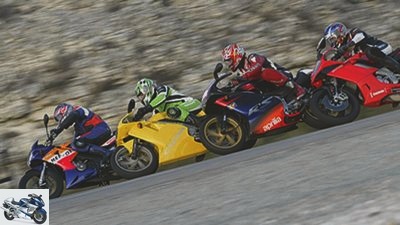
Artist
motorcycles
Comparison test of 125 cc athletes
Comparison test 125 cc sports car, Aprilia RS 125, Cagiva Mito 125, Derbi GPR 125 Racing 4T 4V, Honda CBR 125 R
just do it!
Four 125s. Four tanks full to the brim. And four pilots who want to know. Does the new, cool Derbi GPR leather everything? Makes a MotoGP paint job faster? And anyway: money is more important than honor?
Rolf Henniges
01/04/2005
If we had to talk about money now, the winner of this 125cc athlete comparison would already have been determined. The Honda costs 2740 euros CBR 125 R Despite the new Repsol paintwork, only a little more than half of the competition, which costs around 5000 euros. The saved is enough for
282 movie tickets. Or around 2050 liters of fuel. Or 2282 downloaded songs from the Internet. We don’t want to judge the coolest gig here either. Both the Aprilia RS, Cagiva Mito as well as the new one Derbi GPR Racing could have turned directly from the racetrack into the school yard.
No, it’s about the best bike. away-
on the part of towing factor and brands-
Crush. The showdown is carried out in the class up to a maximum of 15 hp
without speed limit. In the southern French hinterland, in a remote canyon. Two stones mark the start and finish. Jostling. Full throttle. The GPR reaches 80 km / h in 8.1 seconds, just eight
One hundredth behind is the Aprilia. The Honda takes 9.3 seconds and Cagivas Mito 10.9 seconds. Bad numbers. And how does that feel??
Aprilia RS 125: On sale for year and day and so popular with teens
like tight bikinis. Why? The little one
looks like a real superbike.
Beefy cladding, opulent cockpit, rapid paintwork, polished aluminum frame and above all: lots of intelligently arranged space. 1.95-meter pilots feel safe and tots don’t feel lost. The footrests are optimally placed, as are the handles, switches and the handlebars.
So, pull the clutch, go into gear. Gas on. The following applies: Almost nothing works below 5000 rpm. The best thing to do is to turn the shower head on right away. Because the RS has a weak starting point. The first gear has a long gear ratio, which is mandatory for racing, and goes up to 55 km / h. And that’s annoying, especially when riding with a pillion. Above 6000 revs, however, the engine becomes extremely lively. Especially in the last third of the engine speed, between 7000 and 10000 tours, when the competitors all give up, the RS really does. Turns greedily, vibrates moderately and breathes a rather melancholy two-stroke ballad out of the stainless steel rear silencer. Anyone who gulps after the motto “Better dead than lose momentum” will be surprised by the RS with a top speed of 125 km / h. And is extremely stable at the same time.
Cagiva Mito. No doubt: this Italian diva stands out. 40s upside-down fork, aluminum frame, welded seams like works of art, steering damper, banana swing arm, bow cooler ?? It couldn’t be more delicious. It turns out to be ergonomic
Mito 125 as a thoroughbred racing roll. There is no question of sitting on it or being integrated. More like crouching.
If the footrests are too high and too far forward, the knee angle is extreme. The upper body, on the other hand, is stretched long over the tank. But that has something. Feel right from the first meter
you fraternize with Rossi. At least in terms of posture. And the engine? The two-stroke engine delivers its power to the rear wheel gently and fully. Without starting weakness or loss of performance, it turns up evenly and for a racer almost boringly linear, hardly vibrates and loses its guts from 8000 rpm. In the last third of the speed, in the everything-that-goes range, the Mito is significantly weaker than its Italian sister Aprilia RS.
Or the Spanish Derbi GPR. At 134 kilograms, the newcomer is the second lightest in the comparison, and looks a lot like the Honda CBR 600 RR. Pointed nose, fox face, silencer under the stern, radial brake caliper in front. The seating position is MotoGP-like. With a seat height of 825 millimeters, the driver sits three to four centimeters higher on the GPR than on the competition. In addition, the seat falls forward and the handlebars are positioned low. First thought in the seat rehearsal: attack. In gear, disengage, tension the throttle cable. However, it is stiff. Which is why the Derbi gives the impression that the engine reacts sluggishly to commands. Not correct. It hangs spontaneously on the gas, but doesn’t turn up as freely as that
Aggregates of the Aprilia or Cagiva.
In the middle speed range, the Derbi single has the second best pressure behind the Aprilia. However, afterwards, between 6000 and 7000 rpm, there is a full slack. Cruising
is not. If you want to stroll with pleasure between 80 and 100 km / h, you have to constantly switch between fourth and fifth gear. The switch shop is of course all the more necessary in pillion operation. The racy Spaniard reveals her true colors in the narrow range between 7200 and 8000 revolutions. Hallelujah! It roars from the rear, it shakes in the stomach, it tingles in the fingertips. And just go forward. Perceived speed: twice as high as measured? 250 km / h.
Honda CBR 125 R. Be honest, when the top seller parks between the competition? Whether in Repsol paintwork or a simple color dress ??, one thing becomes immediately clear: you don’t even tear open a bag of chips with it. It looks like a pretzel stick next to three butter pretzels. 31 mm stand tube, plain steel swing arm, wheelbase 1295 millimeters and tires in the dimensions 80/90 at the front and 100/80 at the rear. How did a sixteen-year-old judge, looking sideways at the competitors’ 150 and 140 slippers? The Honda has no tires, but road defenders. But let’s leave that.
Seat rehearsal. Fits like a glove. Erectly relaxed. Only the handlebars could be wider. Brings a full tank
the Honda only weighs 124 kilograms, around 20 kilograms less than the Cagiva or Aprilia, and its toy-shaped dimensions immediately convey absolute confidence. Operation is straightforward. Turn clutch, gearshift, throttle grip ?? everything slips, locks exactly and works foolproof. The engine, incidentally the only four-stroke engine in the comparison, turns willingly, but with electric motor charm, towards its limiter at 11,000 rpm. In contrast to the two-stroke engines, the CBR is wonderfully uncomplicated to drive. No performance gaps, no abrupt increase in performance, no starting weakness. Which gear is practically irrelevant? just open the gas and somehow the little one hums forward. In short: The Kurzhuber is as exciting as a sheep count in New Zealand? but: it works!
But back to the canyon described at the beginning. With around 100 km / h the four shoot into the chaos of curves. Grippy asphalt, unfortunately with fat lateral grooves and countless bumps. The cagiva is the fullest. Steering precise, true to the ideal line, very stable. Your chassis is sporty and stiff, but sensitive enough and provides great feedback. Even when braking, the fork swallows any ground attacks. The Mito guides both wheels firmly on the ground. A slight pressure on the leg is enough to change direction. Although the four-piston fixed caliper requires progressive manual force, it decelerates the machine with ease. The rear brake is very snappy and the bike tends to lock up quickly when it is wet.
The Aprilia masters these curves as the second best. Your chassis has more negative suspension travel than that of the competition. During the braking process, the upside-down fork hits the cross-
grooves through, the RS rocks easily. Not threatening, but in comparison
clearly noticeable to the Mito. Steering commands
and course corrections will not be so
implemented directly, the Aprilia looks a bit more sedate.
And the newcomer? Also offers
in this chapter again the highest entertainment value. The fork of the Derbi GPR
is insensitive, twists when braking hard, dips deeply and passes rough blows on. The front wheel-oriented seating position and the steep steering head make the rear very light, especially when braking downhill. More than with the other machines, almost all of the weight is now on the front wheel. And this takes getting used to, especially for newbies to two-wheelers. But quite manageable. And almost irrelevant for quick progress. Because: If the apex is more than 7200 rpm, you sweep the competition up and away anyway. Only the Aprilia can keep up.
The Honda behaves completely differently. The coordination of the CBR chassis was successful. A good mix of sport and comfort with enough reserves and good feedback. But the dainty tires spoil the fun. Due to the size of the cutting disc, the CBR appears unstable and gummy. It wobbles in the curves, is sensitive to longitudinal grooves and therefore not precise. The fact that it can keep up with head-to-head duels is due to its extreme handiness. There is hardly a motorized two-wheeler that can be twirled through curves or big city traffic as easily as the CBR 125 R. Another plus: none
Quirks. The upright sitting position allows a perfect overview, braking, accelerating, blinking, springs or even carrying pillion functions so naturally that you think the motorcycle is part of your own body.
And so the small CBR, made in Thailand and sold all over Asia, is becoming everybody’s darling. Between January and November 2004, 5394 specimens were registered in Germany alone. During the same period Aprilia sold 699 RS and Cagiva 357 Mito. So if it is less about polishing up lap times or image, but rather about bridging distances without breakdowns and stress, there is no getting around the Honda.
Last question: How much do throttles cost-
lunges to 80 km / h? The Mito can be delivered ex works with no extra charge. The others receive throttle sets from Alpha-Technik, which the respective authorized dealers install on site. The Honda costs around 250 euros, the Aprilia’s around 350 euros and the Derbi 190 euros. All prices include parts and TuV entry. Last side note: The CBR only advertises the best towing factor at second glance. As the only one of the Ver-
at the same time it offers a decent pillion seat. And double happiness only costs half.
Buy complete article
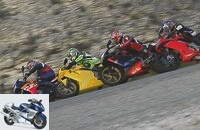
Comparison test of 125 cc athletes
just do it!
8 pages) as PDF
€ 2.00
Buy now
Test result: Honda CBR 125 R
Honda CBR 125 R Okay, she seems a bit anorexic.
Maybe even honest. But it has no real weaknesses and can do a lot better than the competition. That brings her the victory she deserves.
Test result: Aprilia RS 125 Replica
Aprilia RS 125 Replica The design is in the
Years have come. But the most powerful engine and the second-best job secure her second place. Real weaknesses? Not really.
Test result: Cagiva Mito 125
Cagiva Mito 125 When dreams come true, they have nothing in common with everyday life. The Cagiva is a dream. Processing-
processing technology as well as optically. Race freaks cannot ignore it.
Test result: Derbi GPR 125 Racing
Derbi GPR 125 Racing The Spaniards should improve. In terms of consumption, workmanship and chassis. Then the price-performance ratio is right. Otherwise: great optics, great driving.
Scoring: drive
Regardless of the driving condition, even
the four-stroke Honda does not lose its power at low engine speeds
Concept. In addition, the gearbox and clutch work smoothly and precisely. The relatively strong Derbi engine receives a point deduction for the sudden, not practical performance development. The hyper-sporty Cagiva simply lacks top performance.
Scoring: chassis
Almost nothing is handier than a CBR 125. The Honda’s lack of stability is primarily due to
attributed to the narrow tires. The Derbi chassis is missing
it of attenuation and sensitivity.
Scoring: Security
All bikes surprise with good light. The upright seating position and a good view in the mirrors secure valuable points for the Honda. The Derbi fork twists when braking hard.
Scoring: everyday life
Except for fully adjustable spring elements
the Cagiva offers almost everything that makes a full-fledged sports motorcycle. However, your seating comfort is modest. Here scores
the Honda. It also offers real passenger comfort.
Scoring: costs
Cleaner Honda again at the forefront: It consumes and costs the least and shines with the best price-performance ratio. Derbi should take the wonderfully processed Cagiva as an example. After all, both are about the same price.
Technical data: APRILIA RS 125
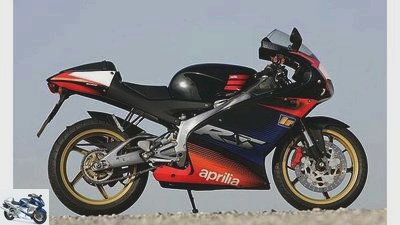
engine
Water-cooled single-cylinder two-stroke engine, a balance shaft, diaphragm inlet, outlet control via electronically operated slide, separate lubrication, flat slide carburetor, Ø 28 mm, alternator 180 W, battery 12 V / 9 Ah, mechanically operated multi-disc oil bath clutch, six-speed gearbox, chain.
Bore x stroke 54.0 x 54.5 mm
Cubic capacity 125 cm3
Compression ratio 12.5: 1
Rated output 11 kW (15 PS) at 11500 rpm
Max. Torque 15 Nm at 6250 rpm
landing gear
Bridge frame made of aluminum, upside-down fork, Ø 40 mm, two-arm swing arm made of aluminum, central spring strut with lever system, front disc brake, Ø 320 mm, four-piston fixed caliper, rear disc brake, Ø 220 mm, two-piston fixed caliper.
Cast aluminum wheels 3.00 x 17; 4.00 x 17
Tires 110/70 ZR 17; 150/60 ZR 17
mass and weight
Wheelbase 1345 mm, steering head angle 64 degrees, caster 88 mm, spring travel f / r 120/120 mm, seat height * 790 mm, weight fully fueled *
141 kg, payload * 178 kg, tank capacity / reserve 14 / 3.5 liters.
Warranty two years
Service intervals every 4000 km
Colors black, black / white
Price including additional costs 4999 euros
Technical data: CAGIVA MITO 125
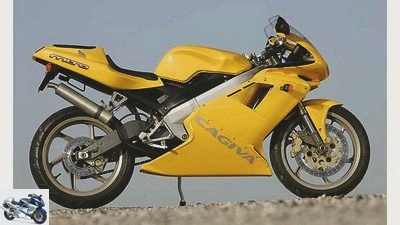
engine
Water-cooled single-cylinder two-stroke engine, membrane inlet, outlet control via electronically operated slide, separate lubrication, round slide carburetor, Ø 28 mm, uncontrolled catalytic converter, alternator 120 W, battery 12 V / 9 Ah, mechanically operated multi-plate oil bath clutch, six-speed gearbox, chain.
Bore x stroke 56.0 x 50.6 mm
Cubic capacity 125 cm3
Compression ratio 7.4: 1
Rated output 11 kW (15 PS) at 8000 rpm
Max. Torque 14 Nm at 5500 rpm
landing gear
Bridge frame made of aluminum, upside-down fork, Ø 40 mm, two-arm swing arm made of aluminum, central spring strut with lever system, adjustable spring base, front disc brake, Ø 320 mm, four-piston fixed caliper, rear disc brake, Ø 230 mm, two-piston fixed caliper.
Cast aluminum wheels 3.00 x 17; 4.00 x 17
Tires 110/70 ZR 17; 150/60 ZR 17
mass and weight
Wheelbase 1375 mm, steering head angle 65 degrees, caster 98 mm, spring travel f / r 120/134 mm, seat height * 785 mm, weight fully fueled *
144 kg, payload * 166 kg, tank capacity 14 liters.
Warranty two years
Service intervals every 6000 km
Colors red, yellow, black
Performance variants 80 km / h throttling
Price 5000 euros
Additional costs 200 euros
Technical data: DERBI GPR 125 RACING

engine
Water-cooled single-cylinder two-stroke engine, membrane inlet in the crankcase, separate lubrication, flat slide carburetor, Ø 28 mm, uncontrolled catalytic converter, alternator 85 W, battery 12 V / 9 Ah, mechanically operated multi-disc oil bath clutch, six-speed gearbox, chain.
Bore x stroke 56.0 x 50.7 mm
Cubic capacity 125 cm³
Compression ratio 12.5: 1
Rated output 11 kW (15 PS) at 8250 rpm
Max. Torque 14 Nm at 7750 rpm
landing gear
Bridge frame made of aluminum, upside-down fork, Ø 40 mm, two-arm swing arm made of aluminum, central spring strut, directly hinged, front disc brake, Ø 300 mm, four-piston fixed caliper, rear disc brake, Ø 180 mm, two-piston fixed caliper.
Cast aluminum wheels 2.75 x 17; 3.50 x 17
110/80 17 tires; 140/70 17
mass and weight
Wheelbase 1355 mm, steering head angle 66 degrees, caster k. A., spring travel f / h 120/110 mm, seat height * 825 mm, weight with a full tank * 134 kg, payload * 170 kg, tank capacity 13 liters.
Warranty two years
Service intervals every 5000 km
Colors red, silver
Price including additional costs 4990 euros
Technical data: HONDA CBR 125 R
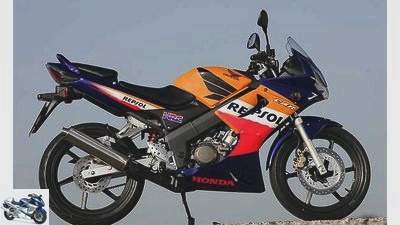
engine
Water-cooled single-cylinder four-stroke engine, an overhead, chain-driven camshaft, two valves, rocker arms, wet sump lubrication, constant pressure carburetor, Ø 28 mm, uncontrolled catalytic converter, 230 W alternator, 12 V / 5 Ah battery, mechanically operated multi-plate oil bath clutch, six-speed gearbox, chain.
Bore x stroke 58.0 x 47.2 mm
Cubic capacity 125 cm3
Compression ratio 11.0: 1
Rated output 10 kW (14 hp) at 10,000 rpm
Max. Torque 10 Nm at 8000 rpm
landing gear
Bridge frame made of steel, telescopic fork, Ø 31 mm, two-arm swing arm made of steel, central spring strut, directly hinged, front disc brake, Ø 276 mm, double-piston floating caliper, rear disc brake, Ø 220 mm, single-piston floating caliper.
Cast aluminum wheels 1.85 x 17; 2.15 x 17
Tires 80/90 17; 100/80 17
mass and weight
Wheelbase 1295 mm, steering head angle 65 degrees, caster 88 mm, spring travel v / h 109/120 mm, seat height * 790 mm, weight with a full tank * 124 kg, load 180 kg, tank capacity 10 liters.
Warranty two years
Service intervals every 6000 km
Colors blue, red, black, Repsol design
Price 2740 euros
Additional costs 130 euros
Related articles
-
Gargolov motorcycles Comparison test: big bikes Comparison test: Big Bikes from Honda and Suzuki Test: Honda CBF 1000 F, CB 1300 S and Suzuki Bandit 1250…
-
Comparison test: Japanese naked bikes
Jahn motorcycles Comparison test: Japanese naked bikes Comparison test: Japanese naked bikes Go big Content of …or go home! Big bore instead of boring,…
-
Comparison test Honda CBF 125 against Yamaha YBR 125
fact motorcycles Comparison test Honda CBF 125 against Yamaha YBR 125 Comparison test Honda CBF 125 against Yamaha YBR 125 Inexpensive 125cc singles No…
-
Comparison test: Supersport 600 series
motorcycles Comparison test: Supersport 600 series Comparison test: Supersport 600 series Screeching traffic Content of They scream their hearts out,…
-
Artist 48 pictures Artist 1/48 Four inexpensive motorcycles have appeared in the south of France … Artist 2/48 Artist 3/48 The winner of the 1000-point…
-
fact motorcycles Comparison test: Honda CBR 600 RR, Kawasaki ZX-6R, Suzuki GSX-R 600, Triumph Daytona 675, Yamaha YZF-R6 Comparison test: Honda CBR 600…
-
Comparison test: 125 cc from Aprilia, Honda, KTM and Yamaha
Breakable 19th pictures Breakable 1/19 The Yamaha MT-125 is the easiest way to climb the 61.3 meter high Pinneberg, the highest point in Heligoland and…
-
Comparison test: large naked bikes
K motorcycles Comparison test: large naked bikes Comparison test: Large naked bikes, Ducati Monster S4, Kawasaki Z 1000, KTM 990 Super Duke R, Triumph…
-
Comparison test: Yamaha YZF-R6 in three expansion stages
Jahn motorcycles Comparison test: Yamaha YZF-R6 in three expansion stages Comparison test: Yamaha YZF-R6 in three expansion stages R6 series vs. Cup vs….
-
Comparison test: 600cc extreme athlete
K motorcycles Comparison test: 600cc extreme athlete Comparison test: 600cc extreme athlete Spear tips Content of They flaunt long lances at the end, are…